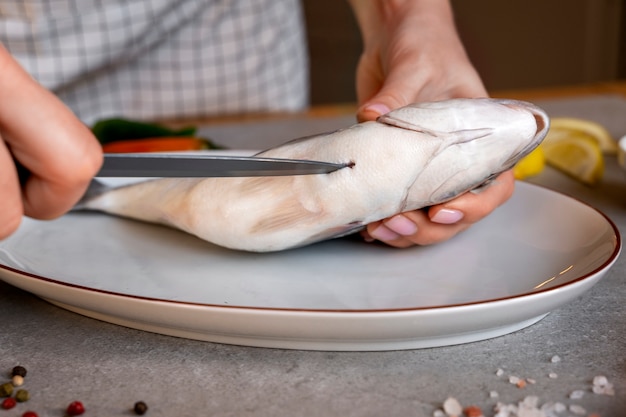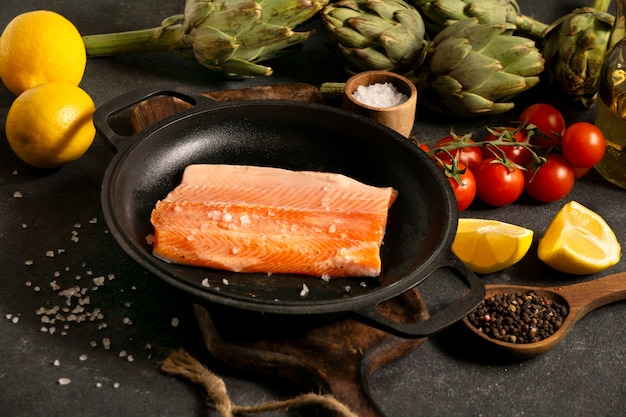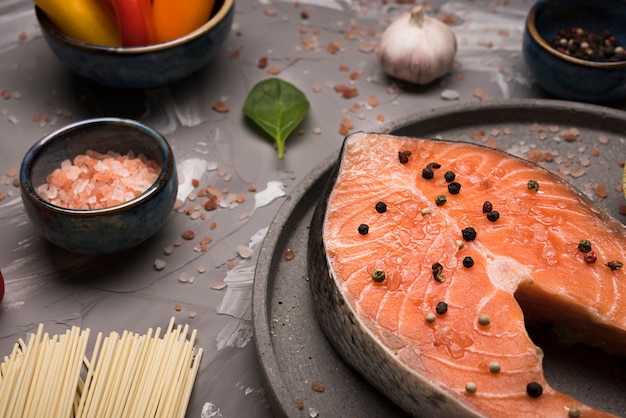I've always been a bit of a fish fanatic. There's something so effortlessly versatile about it, and it's a permanent fixture in my kitchen. But for ages, I struggled with getting salmon just right. It would either be dry and flaky, or worse, undercooked and a bit terrifying. Then, one day, I stumbled upon the magical world of pan-searing. It was a revelation! Suddenly, I could whip up perfectly cooked salmon, with a gloriously crispy skin and tender, moist flesh, every single time. And the best part? It's ridiculously easy.
So, today, I'm going to let you in on my secret to pan-searing salmon. I'll guide you through the process step-by-step, and I'll also share some tips and tricks I've picked up along the way. Get ready to impress your friends and family with this delicious and foolproof recipe.
Part 1: Gathering Your Ingredients

The first thing you'll need is some fresh salmon. I usually go for skin-on, boneless fillets, which are ideal for pan-searing. But hey, if you prefer skinless fillets, go for it. It's your culinary adventure, after all!
choosing the right salmon
When you're picking out your salmon, look for fillets that are firm to the touch and have a vibrant, almost iridescent, colour. Avoid anything that smells fishy or has a dull, grey appearance. The best salmon I've found is often labelled "wild-caught" and comes from sustainable fisheries. It's a bit more of an investment, but trust me, the quality and taste are totally worth it.
Other Ingredients:
Aside from the star of the show, the salmon, you'll need a few other simple ingredients:
- Olive oil: This will be your trusty sidekick for searing the salmon. Choose a good quality extra virgin olive oil for the richest flavour.
- Salt and pepper: These are essential for seasoning the salmon and bringing out its natural flavours. I always use freshly ground black pepper for a more intense flavour experience.
- Lemon: Lemon juice will add a burst of brightness and acidity to the salmon, balancing out its richness. You can also use a few slices of lemon to serve alongside the salmon for a touch of elegance.
- Herbs: Fresh herbs like dill, parsley, or thyme are a wonderful way to elevate the salmon's flavour. I have a particular fondness for a combination of fresh dill and parsley, but feel free to experiment with your favourite herbs. Let your taste buds guide you!
Part 2: Prepping the Salmon

Now that you've gathered your ingredients, let's get the salmon ready for its starring role in our pan-searing drama. This step is all about preparing the salmon for that perfect sear. Think of it as giving the salmon its pre-show pep talk.
Patting Dry
First, pat the salmon fillets dry with paper towels. This step is crucial. It ensures the skin will crisp up beautifully and prevents the salmon from steaming instead of searing. We want a nice, golden brown crust, not a soggy mess!
Seasoning
Next, season the salmon fillets generously with salt and pepper. I like to season both sides, and remember, don't be shy! A good dose of salt really enhances the salmon's natural flavour. It's like giving it a little extra confidence.
Herbs
If you're using fresh herbs, chop them finely and sprinkle them over the salmon. I usually go for a mixture of dill and parsley, but feel free to unleash your inner chef and experiment with other herbs you adore. A sprinkle of fresh rosemary or thyme can add a lovely dimension to the flavour profile.
Part 3: Getting Ready to Sear

With the salmon prepped and ready to go, it's time to prep the stage – the pan, that is. This is where the magic happens, where the salmon transforms from raw to a culinary masterpiece.
Choosing the Right Pan
A good quality cast iron skillet is the ideal choice for searing salmon. It heats up quickly and evenly, creating a gorgeous, crispy skin that's both delicious and impressive. If you don't have a cast iron skillet, a heavy-bottomed stainless steel pan will also do the trick. Just ensure it's nice and sturdy.
Heat is Key
Heat the pan over medium-high heat. You want the pan to be blazing hot, ready to sear the salmon quickly and prevent it from sticking. A hot pan is essential for that coveted crispy skin and beautifully cooked salmon.
Adding Oil
Once the pan is scorching hot, add a generous amount of olive oil. You want the oil to be shimmering and almost smoking before you add the salmon. This is how you create that incredible sear.
Part 4: The Sear
Here we are, the moment of truth! It's time to sear the salmon and create that perfect crispy skin. This is where the real artistry comes in.
Placing the Salmon
Carefully place the salmon fillets skin-side down in the hot pan. Make sure you give them some breathing room, leaving space between the fillets so they can sear evenly. Resist the urge to move them around! Let them cook undisturbed, allowing the heat to work its magic.
Timing is Everything
Cook the salmon for 3-4 minutes, or until the skin is gloriously crispy and golden brown. You might be surprised how quickly this happens, but that's the beauty of a hot pan. You can check for doneness by gently pressing on the skin with a spatula. It should feel firm and spring back slightly.
Flip it!
After those crucial 3-4 minutes, carefully flip the salmon fillets over using a spatula. You may need to use a thin, flexible spatula to get under the skin without breaking it. Now, cook the other side for 2-3 minutes, or until it is cooked to your liking. The salmon should be opaque and flake easily with a fork.
Part 5: Resting and Serving
The salmon is cooked, but don't rush to serve it just yet! It's essential to let it rest before serving.
Resting
Remove the salmon from the pan and place it on a plate. Let it rest for 5-10 minutes before serving. This allows the juices to redistribute, resulting in a moister and more flavorful piece of salmon. It's like giving the salmon a chance to catch its breath and settle in after its hot pan adventure.
Serving
Now it's time to showcase your culinary masterpiece. I like to serve my perfectly seared salmon with a squeeze of fresh lemon juice, a drizzle of olive oil, and some chopped fresh herbs. It's all about those finishing touches. You can also serve it with roasted vegetables, a simple salad, or rice.
Part 6: Tips and Tricks
Here are a few tips and tricks I've picked up along the way that will help you achieve perfect results every time:
- Don't overcook the salmon. Salmon is best cooked medium-rare or medium, so don't overdo it. overcooked salmon will be dry and flaky. It's all about finding that perfect balance of tenderness and flavour.
- Use a meat thermometer. If you're not sure about the doneness of the salmon, use a meat thermometer to check the internal temperature. Salmon is cooked through when it reaches an internal temperature of 125°F (52°C).
- Don't overcrowd the pan. If you cram too many fillets in the pan, the salmon won't sear properly and will steam instead. Give each fillet its own space to shine!
- Use parchment paper. If you're worried about the salmon sticking to the pan, line the pan with parchment paper. This will prevent the salmon from sticking and make cleanup a breeze. It's a little life hack for stress-free cooking.
- Don't be afraid to experiment. There are endless possibilities for flavouring pan-seared salmon. Try different herbs, spices, and sauces to create your own signature dish. Let your creativity flow!
Part 7: Variations and Ideas
Now that you've mastered the basics, let's explore some fun and flavourful variations of pan-seared salmon. Get ready to spice things up!
Citrus Burst
This variation adds a zesty kick to the classic pan-seared salmon. Before searing, rub the salmon fillets with the zest and juice of one orange and one lemon. Season with salt, pepper, and fresh thyme. The citrusy flavours will dance on your taste buds, creating a vibrant and refreshing dish.
Asian Inspiration
For an Asian twist, marinade the salmon fillets in a mixture of soy sauce, mirin, ginger, and garlic for 30 minutes before searing. Serve with a side of rice and steamed vegetables. This variation will transport you to a world of aromatic flavours and textures.
Mediterranean Delight
This variation is all about fresh and bright flavours, perfect for a warm summer evening. Before searing, brush the salmon fillets with olive oil and sprinkle with chopped fresh oregano, rosemary, and lemon zest. Serve with a side of roasted cherry tomatoes and feta cheese. The combination of herbs, citrus, and tangy feta creates a symphony of taste sensations.
Part 8: Beyond the Pan
While pan-searing is a fantastic way to cook salmon, it's not the only method. Here are a few other options to explore:
grilled salmon
Grilling salmon is a great way to enjoy it during warmer weather. Simply grill the salmon over medium heat for 3-4 minutes per side, or until cooked through. The smoky flavour of the grill adds a unique dimension to the salmon.
baked salmon
For a hands-off approach, try baking salmon. Preheat your oven to 400°F (200°C). Place the salmon fillets on a baking sheet lined with parchment paper. Bake for 12-15 minutes, or until cooked through. This method is perfect for a busy weeknight when you need a simple and delicious meal.
smoked salmon
Smoked salmon is a delicious and versatile treat. You can buy it pre-smoked or try smoking it yourself at home. Smoked salmon is perfect for appetizers, salads, and sandwiches. It's a wonderful way to add a touch of indulgence to your meals.
Part 9: FAQs
You may have some questions about pan-searing salmon. Here are some frequently asked questions and their answers:
| Question | Answer |
|---|---|
| How do I know if the salmon is cooked through? | The salmon should be opaque and flake easily with a fork. You can also check the internal temperature with a meat thermometer. Salmon is cooked through when it reaches an internal temperature of 125°F (52°C). |
| What if the salmon sticks to the pan? | If the salmon sticks to the pan, it's likely that the pan wasn't hot enough. Make sure the pan is scorching hot before adding the salmon, and use a good quality oil. |
| Can I use frozen salmon? | Yes, you can use frozen salmon, but it's best to thaw it completely before searing. You can thaw it in the refrigerator overnight or in a bowl of cold water. Allowing it to thaw properly will ensure a more consistent and flavorful result. |
| What can I serve with pan-seared salmon? | You can serve pan-seared salmon with a variety of side dishes, such as roasted vegetables, a simple salad, or rice. I also love to serve it with a squeeze of lemon juice, a drizzle of olive oil, and some chopped fresh herbs. |
| How do I store leftover salmon? | Store leftover salmon in an airtight container in the refrigerator for up to 3 days. You can reheat it in the microwave or oven. Make sure to reheat it thoroughly before eating. |
I hope this guide has inspired you to try pan-searing salmon at home. It's a simple yet impressive dish that's perfect for any occasion. So go forth, experiment with different flavours, and enjoy your delicious, perfectly cooked salmon!
Everyone is watching

Corn on the Cob: The Ultimate Guide to Perfectly Cooked Ears
Healthy MealsAh, corn on the cob. Just the name evokes images of sunny days, barbecues, and that sweet, juicy flavour that ...

Perfect Pork Roast Oven Cooking Time: A Guide to Delicious Results
Healthy MealsThere's something truly satisfying about a perfectly roasted pork. The aroma alone is enough to make your mout...

Ham Cooking Time: How Long to Bake, Smoke, or Boil a Delicious Ham
Healthy MealsAh, ham. It's a classic, isn't it? A real crowd-pleaser, especially around holidays. And when done right, it'...

Scallops: The Ultimate Guide to Perfect Cooking
Healthy MealsAh, scallops. Those delicate, sweet, and utterly delicious morsels of the sea. They hold a special place in my...

Spaghetti Squash: The Ultimate Guide to Cooking and Serving
Healthy MealsRemember that time you saw spaghetti squash at the supermarket, looking all bumpy and strange, and thought, "W...
